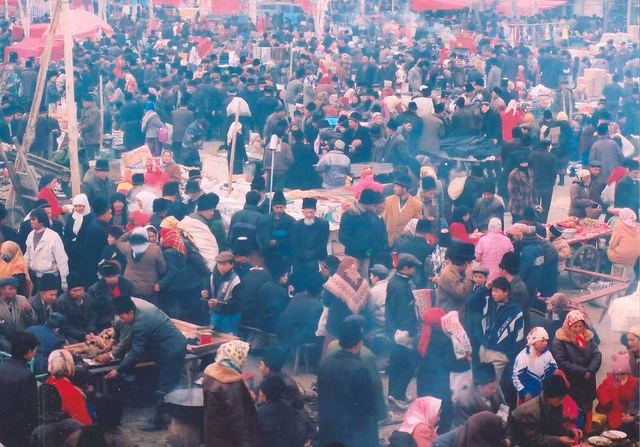Prospective Republican presidential candidate Ben Carson made the claim during the GOP primary on 13 November that with respect to the Syrian crisis Americans ‘must recognise that it’s a very complex place. You know, the Chinese are there, as well as the Russians, and you have all kinds of factions there’.
The Obama administration has ridiculed the claim with the President dismissively attributing it to the fact that Carson ‘doesn’t know much about it [Syria],’ while a White House spokesperson suggested that ‘China has a history of staying out of conflicts in the Middle East’.
The administration was right to dismiss Carson’s claim as erroneous. However it nonetheless underlines increasingly evident frustration in the West that China, while claiming the rights and status of a great power, hasn’t assumed the responsibilities of one.
According to some, no state has benefitted more from the US’ misadventures in the Middle East and Central Asia than China. Those military commitments, and the ‘war on terrorism’ associated with them, have distracted two successive US presidents from constructing consistent and coherent responses to China’s accrual of increasing military and diplomatic capabilities in Asia. To rub salt into US wounds Beijing has been the consummate ‘free rider’ in both Iraq and Afghanistan, utilising the American (and NATO in the case of the latter) provision of security to invest heavily in those countries oil and resources sector while steadfastly refusing entreaties for Chinese engagement in the stabilisation of them. This sentiment has also been expressed by President Obama, much to the displeasure of Beijing.
China’s approach to both of the US’ wars in Syria and Afghanistan however reflects Beijing’s anxieties about both its own position in international affairs and the security situation in Xinjiang.
David Shambaugh has eloquently argued that China remains a ‘partial power’ whose international diplomacy ‘often makes it known what it is against, but rarely what it is for’. This makes China’s foreign policy in many regions of the world ‘hesitant, risk averse and narrowly self-interested’.
This characterisation accurately describes China’s approach to the Syrian crisis and Afghanistan to date.
In Syria, China’s insistence on the principle of ‘non-intervention’ and its exhortations that only a ‘political settlement’ can resolve it don’t stem from any deep relations with the Assad regime. Unlike Russia, Beijing has limited economic and military ties to Damascus. Rather, Beijing’s opposition to the US-led efforts regarding Syria is linked to its desire to protect its reputation both at home and abroad. Key here is Beijing’s experience during the overthrow of Muammar Qaddafi in Libya where its abstention from UN Security Council Resolution 1973 paved the way for NATO military intervention. Internationally, that raised questions about the sanctity of Beijing’s principle of ‘non-interference’ upon which it had built much of its diplomatic successes since the end of the Cold War. Domestically, it suggested that the rulers in Zhongnanhai had compromised core principles and acquiesced too quickly to Western pressure.
China’s approach to Afghanistan has also be similarly cautious. To date it has been focused on achieving political reconciliation between Kabul and the Taliban—what it terms an ‘Afghan-led and Afghan-owned’ peace process—and fostering economic development. A key element of Beijing’s strategy to encourage the former has been based on the assumption that it can leverage its ‘all weather’ friendship with Pakistan to compel the Taliban to the negotiating table and assist it in clamping down on a small number of Uyghur militants operating along the Af–Pak frontier.
With respect to the latter, Afghanistan has emerged as a key link in the ‘Silk Road Economic Belt’ (SREB) facet of President Xi Xinping’s ‘One Belt, One Road’ (OBOR) strategy. The SREB’s focus on the development of trans-regional infrastructure links and investment across Central Eurasia including the planned $46 billion ‘China-Pakistan Economic Corridor’ (CEPC)—linking Kashgar in Xinjiang’s south-west with the largely Chinese built deep-water port of Gwadar on Pakistan’s Arabian Sea coast—and the Anyak copper mine in Afghanistan’s Logar province, the OBOR looks set to give China a greater stake in the future security and prosperity of Central Asia, Afghanistan and Pakistan.
Those approaches would now appear to be of diminishing utility due to a number of developments that are bringing the threat of ISIS, and radical Islamism more broadly, home to Beijing.
First, on 10 September ISIS published an ‘advertisement’ in its online magazine Dabiq featuring Norwegian and Chinese hostages, Ole Johan Grimsgaard-Ofstad and Fan Jinghui, which it claimed were being ransomed in a ‘limited time offer’. ISIS subsequently claimed on 18 November that both men had been ‘executed after being abandoned by kafir nations and organisations’, a claim verified by both men’s respective governments. President Xi, condemning the murders as ‘ruthless’ attacks on the ‘baseline of human civilization’, has vowed to bring the perpetrators to justice.
This follows Chinese claims of ISIS’ active recruitment of Uyghurs from its restive province of Xinjiang to fight in Syria and Iraq and reports of the deaths of 28 Uyghur ‘terrorists’ in southern Xinjiang after a 56 day ‘manhunt’.
Second, reports of ISIS inroads among some sections of the Taliban looks set to make China’s preferred option of a negotiated political settlement to conflict there anytime soon unlikely. Additionally, the fact that the Islamic Movement of Uzbekistan (IMU), one of Central Asia’s most resilient jihadist groups, has also reportedly switched its allegiance from the Taliban to ISIS will also be of major concern for Beijing given that the IMU has in the past hosted Uyghur militants in camps along the Af–Pak frontier.
The question now remains as to how Beijing will choose to respond now that the threat of ISIS has begun to impinge on its direct national interests in Xinjiang, Central Asia and the Middle East. Will it modify its ‘non-intervention’ principle in the interests of combatting ISIS? Or will it simply seek, as it has in the past, to leverage international concern with radical Islamism to enhance the legitimacy of its hard-line in Xinjiang?


